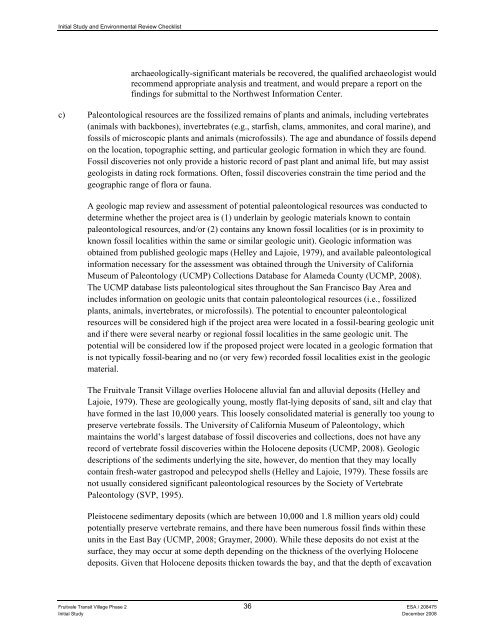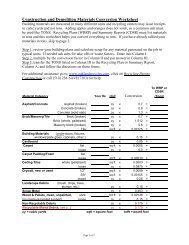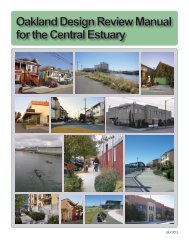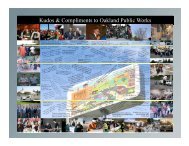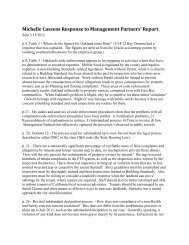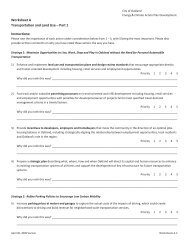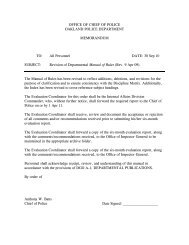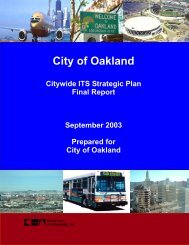Fruitvale Transit Village (Phase 2) Initial Study - City of Oakland
Fruitvale Transit Village (Phase 2) Initial Study - City of Oakland
Fruitvale Transit Village (Phase 2) Initial Study - City of Oakland
Create successful ePaper yourself
Turn your PDF publications into a flip-book with our unique Google optimized e-Paper software.
<strong>Initial</strong> <strong>Study</strong> and Environmental Review Checklistarchaeologically-significant materials be recovered, the qualified archaeologist wouldrecommend appropriate analysis and treatment, and would prepare a report on thefindings for submittal to the Northwest Information Center.c) Paleontological resources are the fossilized remains <strong>of</strong> plants and animals, including vertebrates(animals with backbones), invertebrates (e.g., starfish, clams, ammonites, and coral marine), andfossils <strong>of</strong> microscopic plants and animals (micr<strong>of</strong>ossils). The age and abundance <strong>of</strong> fossils dependon the location, topographic setting, and particular geologic formation in which they are found.Fossil discoveries not only provide a historic record <strong>of</strong> past plant and animal life, but may assistgeologists in dating rock formations. Often, fossil discoveries constrain the time period and thegeographic range <strong>of</strong> flora or fauna.A geologic map review and assessment <strong>of</strong> potential paleontological resources was conducted todetermine whether the project area is (1) underlain by geologic materials known to containpaleontological resources, and/or (2) contains any known fossil localities (or is in proximity toknown fossil localities within the same or similar geologic unit). Geologic information wasobtained from published geologic maps (Helley and Lajoie, 1979), and available paleontologicalinformation necessary for the assessment was obtained through the University <strong>of</strong> CaliforniaMuseum <strong>of</strong> Paleontology (UCMP) Collections Database for Alameda County (UCMP, 2008).The UCMP database lists paleontological sites throughout the San Francisco Bay Area andincludes information on geologic units that contain paleontological resources (i.e., fossilizedplants, animals, invertebrates, or micr<strong>of</strong>ossils). The potential to encounter paleontologicalresources will be considered high if the project area were located in a fossil-bearing geologic unitand if there were several nearby or regional fossil localities in the same geologic unit. Thepotential will be considered low if the proposed project were located in a geologic formation thatis not typically fossil-bearing and no (or very few) recorded fossil localities exist in the geologicmaterial.The <strong>Fruitvale</strong> <strong>Transit</strong> <strong>Village</strong> overlies Holocene alluvial fan and alluvial deposits (Helley andLajoie, 1979). These are geologically young, mostly flat-lying deposits <strong>of</strong> sand, silt and clay thathave formed in the last 10,000 years. This loosely consolidated material is generally too young topreserve vertebrate fossils. The University <strong>of</strong> California Museum <strong>of</strong> Paleontology, whichmaintains the world’s largest database <strong>of</strong> fossil discoveries and collections, does not have anyrecord <strong>of</strong> vertebrate fossil discoveries within the Holocene deposits (UCMP, 2008). Geologicdescriptions <strong>of</strong> the sediments underlying the site, however, do mention that they may locallycontain fresh-water gastropod and pelecypod shells (Helley and Lajoie, 1979). These fossils arenot usually considered significant paleontological resources by the Society <strong>of</strong> VertebratePaleontology (SVP, 1995).Pleistocene sedimentary deposits (which are between 10,000 and 1.8 million years old) couldpotentially preserve vertebrate remains, and there have been numerous fossil finds within theseunits in the East Bay (UCMP, 2008; Graymer, 2000). While these deposits do not exist at thesurface, they may occur at some depth depending on the thickness <strong>of</strong> the overlying Holocenedeposits. Given that Holocene deposits thicken towards the bay, and that the depth <strong>of</strong> excavation<strong>Fruitvale</strong> <strong>Transit</strong> <strong>Village</strong> <strong>Phase</strong> 2 36 ESA / 208475<strong>Initial</strong> <strong>Study</strong> December 2008


